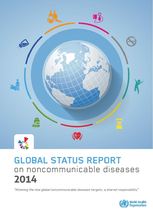New NCD report:
Number of premature and avoidable NCD deaths on the rise
World Health Organization (WHO) has released a new Global Status Report on Nonommunicable Diseases (NCDs). The report states that most premature NCD deaths are preventable. Of the 38 million lives lost to NCDs in 2012, 16 million or 42% were premature and avoidable – up from 14.6 million in 2000.
The increasing burden from NCDs was the topic of a UN High Level Meeting in 2011 where world leaders agreed on a roadmap of concrete commitments to address the global burden of NCDs, including a commitment to establish multisectoral action plans and policies for the prevention and control of NCDs.
The four main categories of NCDs are cardiovascular diseases, cancer, diabetes and chronic respiratory diseases, which share four modifiable behavioural risk factors: Tobacco use, physical inactivity, unhealthy diet and the harmful use of alcohol. The toll from NCDs is increasing, reaching 16 million people dying prematurely in 2012 – before the age of 70.
The new report calls for more action to be taken to curb the epidemic, particularly in low- and middle-income countries, where deaths due to NCDs are overtaking those from infectious diseases. Almost three quarters of all NCD deaths (28 million), and 82% of the 16 million premature deaths, occur in low- and middle-income countries.
Alcohol is one of the risk factors for NCDs featured in the report. WHO points out that In 2012, an estimated 5.9% (3.3 million) of all deaths worldwide and 5.1% of disability-adjusted life years (DALYs) were attributable to alcohol consumption. More than half of these deaths resulted from NCDs.
There are cost-effective policy options to reduce the harmful use of alcohol. They include pricing policies, reduced availability and marketing of alcohol, improved response by health services, and drink-driving policies and countermeasures. Increasing numbers of countries have developed or reformulated their national alcohol policies and action plans. Of 76 countries with a written national policy on alcohol, 52 have taken steps to operationalize it.
RELATED ARTICLES
- New report highlights benefits of policy measures to prevent harmful alcohol consumption
- WHO consultation on global alcohol strategy and the way forward
- Alcohol use - a barrier to health and to the achievement of the SDGs
- Government investments in alcohol industry up against the wall
- Abstracts for GAPC 2020 – deadline 29 July 2019
- A regional African alcohol coordination mechanism is needed
- New book reveals a series of unethical business practices by Heineken in Africa
- SAAPA applauds WHO position on no industry collaboration
- Next GAPC to be held in Dublin in March 2020
- SAFER – a new WHO initiative to boost national alcohol policy processes

